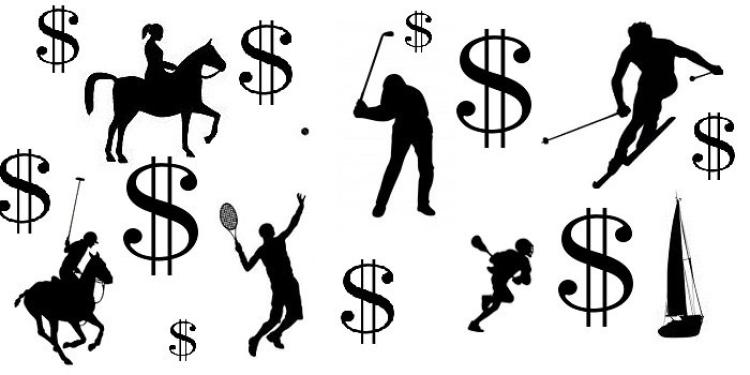The Sports most often Played by the Rich
Posted: July 6, 2015
Updated: October 6, 2017

A look at some sports that are enjoyed by the wealthy
Some people today like to make the claim that “poor people only play sports.” This line of thought is highly inaccurate. From the viewpoint of anthropologists, sport is something that followed art, religion and philosophy practiced first by people who already had farmed, hunted and had the time for other pursuits.
• Aristocrats wanted to keep the working class from these activities
• The high costs of riding have “hijacked” this activity from the masses
• Though Crew is considered prestigious, most U.S. colleges offer it
Along that logic, the more secure a person was, the more time they had to devote to sport.
In 18th century England, several sports were changing to their modern form. The ruling classes and the aristocrats who enjoyed sports wanted to keep working class people separated from these activities. Titles such as amateurism were created to secure their interests. Some of these sports were able to maintain their “mystique” of higher class status even to this day. Let’s look at some of these sports.
Two sports with balls make up the first four

Sports with raquets have always been embraced and protected by the elite. Tennis, squash and racquetball require courts which were once only located at special “clubs.” Through membership fees, these clubs could keep away people with less money. Although tennis is more prevalent and available to more people, the prices for racquets and equipment still may keep many at bay. Squash is still “protected” to this day.
Some sports that the rich partake in seldom make gambling news. Jai Alai is one of the examples. Stemming from the Basque region in Spain, jai alai is played by hurling a ball with a curved, hand-held basket against a wall. Once recognized as the “world’s fastest sport”, the pelota or ball can move at speeds over 100 mph. In the past 100 years, the sport has been gambled on by the rich more than it’s been played.
Sailing is a definitive sign of wealth. During the times of the explorers, most of the ships navigated by people like Columbus and Magellan were funded by wealthy people who wanted first pick at the “spoils” that were discovered. Often in sailing competitions, the boat, crew and registration fees are given by rich benefactor who often will take part in the competition. Sailing requires exorbitant fees for boats, dock fees, crews and a licensed operator.
Polo is often considered the most elitist sport in the world. Its exclusivity is directly linked to its lack of access. Find a polo match isn’t the easiest act, nevertheless getting into the club where it’s played. The best polo competition takes place within the confines of societies “upper crust.” Apart from expensive horse maintenance, equipment and sponsorships for competition cost money. If wearing a shirt with a polo player on it costs money, imagine the price involved in actually participating in the sport?
Five more sports complete the list

Riding is a well-known sport amongst the “well to do.” Along with skiing and shooting, riding is one of those practices that people long ago had to partake in as a means of survival rather than personal entertainment. Unfortunately, the high costs of riding have “hijacked” this activity from the masses. Often the horse is cheaper than the stable fees. Equipment and competition fees can be costly too and vary based on what type of riding takes place.
Although you may not find it on any online sportsbooks in the US, Lacrosse is another sport “stolen” from the masses. Or more accurately, it was stolen from Native Americans who had it connected to their culture for centuries. Lacrosse is a stable, along with field hockey, among preparatory schools. Although the equipment costs, the fees aren’t greater than American Football. The status of this sport is more a product of where it’s available than the actual degree of costs involved.
Skiing has an “aura” of wealth about it. The sport is quite inconspicuous as a result of the media’s constant portrayal of skiing as it relates to elitism. The reality is that more people who lack money ski, than people who have it. Small towns with ski slopes have always allowed access their slopes by the local “folk.” Places like Aspen, Vail and Killington have been connect to the limelight with images of hot tubes, private cabins and uber fashionable ski wear.
It has been shown repeatedly the connection between wealth and water. Fishermen are working class, yet sports fishing required time and money. The team boating sport of Crew is no exception. Although its origins lie in England with a great deal of pride, the American Ivy Leagues easily rival their Anglo counterparts in skill and prestige. In reality, most U.S. colleges offer a crew program or club.
Golf remains the universal game of wealth. Apart from any elitism, the costs alone can be staggering. Golf clubs are expensive as well as the course people play on. A golf course can cost as much as USD 5 or USD 500 an hour. Country clubs are often the last bastions of elitism left in the world. Many golfing clubs still limit people access based on their race, creed or social level. Notables in US gambling news, like the multi-racial Tiger Woods, had created greater interest in the sport and put a profound “dent” into its impermeability.












